In this issue, we provide:
- Some national perspectives from the IEC TC34 meetings in Sydney, 25-29 May 2015;
- An update on the testing element of Southeast Asia and Pacific Monitoring, Verification and Enforcement Project lamp sampling and testing exercise;
- Details about a consultation paper recently released by the Australian and New Zealand Governments on commercial lighting;
- An introduction to the new UNEP-GEF en.lighten initiative guidance note on the development of minimum energy performance standards for lighting products;
- Information on the United for Efficiency (U4E) initiative;
- A summary of the key points from the SWITCH-Asia Regional Networking Conference in Jakarta, featuring the UNEP-GEF en.lighten initiative;
- Information on new World Bank guidance for the development and implementation of energy efficient street lighting projects;
- Information on UNEP-GEF en.lighten initiative webinars.
Sydney IEC Lighting and Related Equipment Working Group Meetings

Image courtesy of Vivid Sydney 2015. Sydney Opera House Living Mural Universal Everything, 8 June 2015
The International Electrotechnical Commission (IEC) TC34, Lighting and Related Equipment, committee held its four working group meetings (PRESCO, EPC, COMEX, LUMEX), and a number of panel meetings, between 25 May and 5 June 2015 in Sydney, Australia. The meetings coincided with the International Year of Light, the VIVID Sydney festival, SPARC International Lighting Event and IEA 4E Solid State Annex expert group meetings. As part of its activities under the Southeast Asia and Pacific Monitoring, Verification and Enforcement Project, supported by the Australian Government, the UNEP-GEF en.lighten initiative sponsored the attendance of lighting standards representatives from Indonesia and the Philippines at the PRESCO, EPC, COMEX, LUMEX meetings and the associated light emitting diode (LED) workshop. These working groups oversee the work on each aspect related to standards development for lamps, control gear, accessories; and luminaires and the representatives welcomed this opportunity to directly inform themselves of the current status of IEC lighting and related equipment standards and to participate, observe, and learn from, the process for formulating the technical standards being carried out by members of the working group.
While the working groups carry out maintenance of existing technology standards, a substantial and increasing effort is being directed into new standards development, or modification of existing standards, to accommodate LED or organic light-emitting diode (OLED) technologies and the new, or different, safety or performance aspects they require. This includes development of standards for luminaire performance, such as IEC 62722-2-1:2014, Luminaire performance - Part 2-1: Particular requirements for LED luminaires. While performance standards for existing technology lamps and control gear have existed for many years, the more mainstream use of LEDs has forced the development of separate luminaire performance standards and performance standards for LED lamps and control gear have also had to be developed. It was felt by the representatives that this increase in the number of LED-related standards should eventually accelerate implementation of lighting efficiency efforts, particularly for developing countries.
Speaking from a personal perspective on the benefits of national participation in IEC technical working groups, the Indonesian and Philippine representatives highlighted the opportunity this presents for: keeping abreast of the essential information and resources related to IEC technical work for standards development; direct involvement in the standard development process itself; and for presenting national or regional positions or proposals.
It was further observed that, although the IEC has always promoted the participation of National Committees, regulators, advocacy and other groups from member countries in their working group meetings, there were very few representatives from these groups at the Sydney meetings. It was felt that greater participation from these groups would be beneficial to give more user inputs to the outcome of the meetings.
The next IEC TC34 plenary and four working group meetings will be held in Denver, United States of America during October 2015.
Regional Lamp Performance Testing Activity
The last newsletter reported on the preliminary findings of testing activities undertaken by the Global Efficient Lighting Centre in Beijing, China on lamps collected during a lamp sampling exercise undertaken by the UNEP-GEF en.lighten initiative in collaboration with six Southeast Asian countries (Cambodia, Indonesia, Lao PDR, Philippines, Thailand and Viet Nam) as part of its Australian government supported Southeast Asia And Pacific Monitoring, Verification And Enforcement Project. These preliminary findings, on the testing of 80 models of compact fluorescent lamps (CFLs), suggested that there are quality issues with some models from all of the countries – primarily with efficacy and colour quality (as represented by colour rendering index and standard deviation colour match).
Since this time, the analysis of the results for lamp power, power factor, luminous flux, efficacy, colour rendering index, correlated colour temperature and standard deviation colour match of these CFL models has been completed, along with testing of the luminous maintenance after 2,000 hours. In addition, the testing of the 20 LED lamps sampled in the six countries as part of the original lamp sampling exercise has been finalised.
COMPACT FLUORESCENT LAMP TESTING
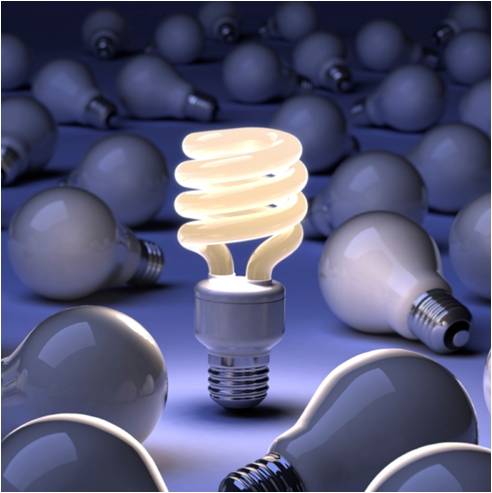 |
Efficacy The analysis of the testing results indicates that the average luminous efficacy of all models was 57 lm/W, with most of the samples being within the range 45 - 65 lm/W. However the lowest was 39 lm/W and the highest was 70 lm/W.
Colour rendering index (CRI) The average CRI of all models was 82, with 93.8% of the models within the range of 5% of this average and 90% with a CRI of more than 80. Two models showed a deviation in CRI of more than -10%, with the worst performing model showing a deviation of -37%.
Luminous maintenance The 2,000 hour lumen maintenance results showed good average maintained light output (87%) across the 80 tested models (against IEC 60969, Self- ballasted lamps for general lighting services - |
Performance requirements). 95% of the models tested within ±10% of this average. However, two models had a luminous maintenance of below 75%, which is poor.
LIGHT EMITTING DIODE LAMP TESTING
|
In total, 20 models of LED lamps were received for performance testing from Cambodia, Indonesia, Lao PDR, Philippines, Thailand and Viet Nam. Of these, the majority were 5 W (40%) and 7 W (25%) lamps, but the sample also included 6 W, 6.5 W, 7.5 W, 8 W, 9 W and 11 W lamps. The lamps were mainly sampled from specialised lighting shops (45%) and electrical/hardware shops (40%), with the remaining lamps coming from other locations, such as shopping malls.
Each model of lamp was tested for lamp power, power factor, luminous efficacy, CRI and light distribution. All the tests (except light distribution) were conducted according to the IEC standard, IEC/PAS 62612, Self-ballasted LED-lamps for general lighting services - Performance requirements. The light distribution test was conducted according to the Illuminating Engineering Society Approved Method |
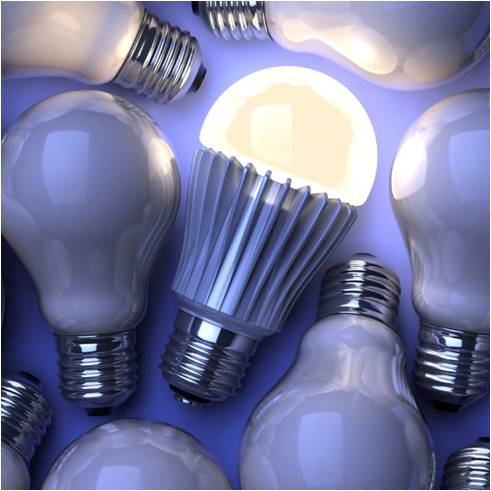 |
for Electrical and Photometric Measurements of Solid-State Lighting Products, IES LM79-08. As per the requirements of IEC/PAS 62612, the initial performance tests were conducted at 0 hours without ageing; while a second stage of performance tests were conducted at 1,000 hours, to compare with the initial test results.
In summary, the testing revealed that:
- 80% of the models demonstrated power values less than the rated power, the maximum difference being 50% (46% at 0 hours and 56% at 1,000 hours);
- The average power factor across the 5W models was 0.53, and that of the models with power greater than 5W was 0.65. However, many of the models deviated significantly from this average (the lowest was less than 0.3, while the highest was greater than 0.8), which may mean that some lamps may not meet requirements in some regions;
- The average luminous efficacy for the models was 82 lm/W, with a range of 54 lm/W to 106 lm/W. More than 75% of the models were located in the range of 70 lm/W to 100 lm/W;
- The average CRI of the models was 79, with nearly 60% of the models deviating from this by only 5%-10% (although the maximum deviation was about 15%). Approximately half of the samples had a CRI of less than 80.
When comparing the results of the 0 hour and 1,000 hour tests:
- Luminous efficacy showed the largest differences, with 11 models showing increased luminous efficacy at 1,000 hours and 9 models showing decreased efficacy. The luminous efficacy changes were higher than those for the power, which means that during the 1,000 hours, the total luminous flux had increased or decreased more than the power. These results raise issues about whether the initial ageing process for LEDs is sufficient to stabilise the lamps (and hence attain their full light output) before testing and, in the cases where efficacy has declined quickly, whether the lamps will be able to meet claimed lifetime;
- 25% of the test results at 1,000 hours showed decreased power compared with the test results at 0 hours;
- The majority of the models showed very small changes (less than 1%) in power factor between the tests (except for one model whose power factor increased by 7.3%);
- CRI showed the least variation between the tests.
These results therefore demonstrate different quality levels amongst the 20 LED models tested. The higher quality models had stable power, high power factor, high efficacy, and high CRI rendering index, while the lower quality models showed large variation from the rated power, low power factor, low efficacy and low CRI.
The generic results for from the testing of both the LED lamps and CFLs will be published and distributed to the lites.asia members later in 2015.
Australia and New Zealand Release Commercial Lighting Consultation Paper (with LED paper to follow)
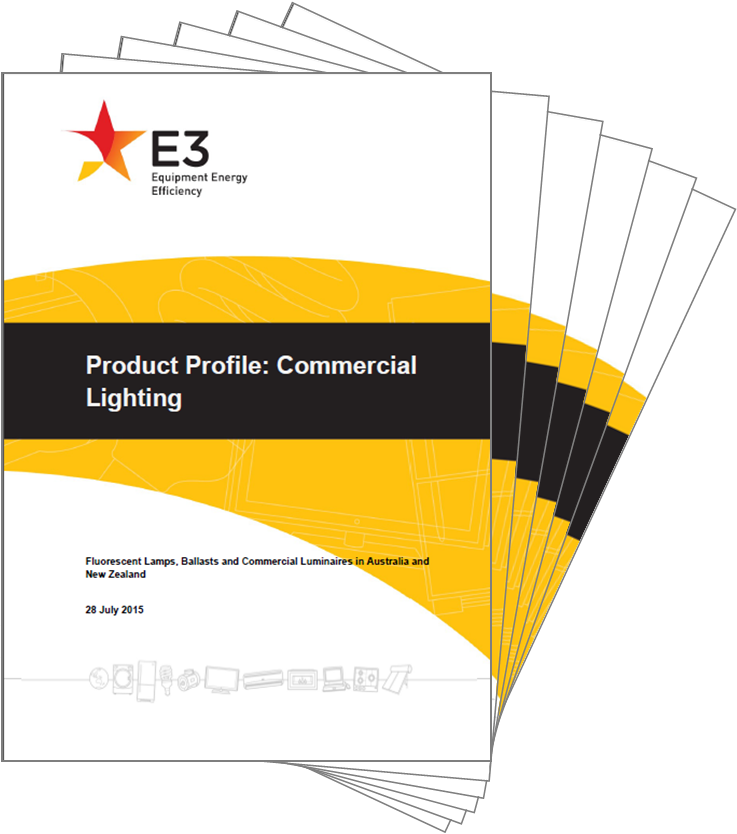 |
The Australian, State, Territory and New Zealand Governments have released a discussion paper on the future regulation of Commercial Lighting products.
Lighting in Australia and New Zealand is a major contributor to energy use and cost in the commercial sector with commercial lighting systems accounting up to 40% of electricity end-use. A range of linear (double-capped) fluorescent lamps and ballasts have been subject to minimum energy performance standards (MEPS) and labelling requirements since 2002 in New Zealand and 2004 in Australia.
Taking into account the emergence of more efficient commercial lighting products and the introduction of more stringent MEPS levels in a number of other major economies; it was considered timely to review the MEPS program for linear fluorescent lamps and ballasts and to consider options for increasing |
the efficiency of basic commercial luminaires, circular and U-shaped fluorescent lamps, and non-integrated CFLs.
The paper outlines a range of possible policy options include increases to MEPS levels for fluorescent lamps and ballasts, updated harmonisation with international test standards and product categories, and the introduction of a voluntary or mandatory MEPS for commercial luminaires.
Views are now being sought from industry, consumers and other stakeholders to assist in addressing information gaps to ensure that any further regulatory proposals and cost-benefit modelling facilitates informed decision-making. Final policy options would be subject to detailed investigation through a Regulatory Impact Statement (RIS).
A copy of the report may be downloaded from the Energy Rating website. It is expected that a discussion paper on options for action on LED lighting will be released in mid-August for consultation and will also be available on the Energy Rating website.
Accelerating the Deployment of Efficient Lighting Solutions Through Minimum Energy Performance Standards
The UNEP-GEF en.lighten initiative released their new guidance note, Developing Minimum Energy Performance Standards for Lighting Products during the SWITCH-Asia regional event – Advancing Energy Efficiency in Asia Through SCP and Green Finance – in Jakarta in July. This practical resource for governments will help policymakers better understand the benefits of minimum energy performance standards (MEPS) for achieving their energy efficiency goals.
|
Electricity for lighting accounts for almost 15% of electricity consumption and around 6% of CO2 emissions worldwide. MEPS offer a fundamental foundation for any Government striving to accelerate the deployment of efficient lighting solutions on a permanent and sustainable basis. Coupled with enabling legislation and an effective compliance strategy, they facilitate a transition to more efficient lighting by specifying the minimum energy efficiency of the products that may be offered for sale in the market.
This new UNEP-GEF en.lighten initiative guidance note provides a practical resource for governments on the issues to consider when establishing MEPS in their country. It outlines a step-by-step approach to integrating MEPS into national policies and strategies, and provides practical advice, reinforced by case studies, drawn from the experiences of those countries and regions already enforcing efficient lighting MEPS. |
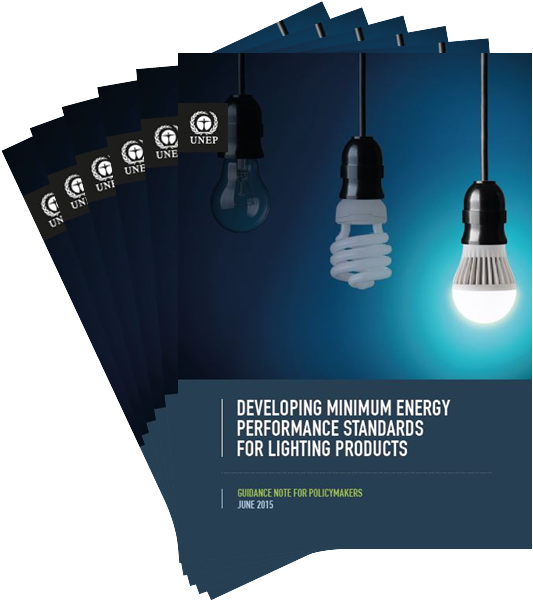 |
Speaking from Jakarta, Dr Sanjayan Velautham, Executive Director of the ASEAN Center for Energy, highlighted the relevance of the guidance note: “Minimum energy performance standards can go a long way as part of a package of measures to improve energy efficiency and contribute in our efforts to reduce greenhouse gases emissions in the ASEAN region. This publication comes timely with the ASEAN harmonization of lighting standards which will be initiated this year.”
UNEP hopes that governments will be inspired by the case presented and will make it a reality by developing and implementing lighting MEPS in support of energy efficiency and climate change mitigation.
To download a copy of the guidance note, click here.
United for Efficiency Initiative
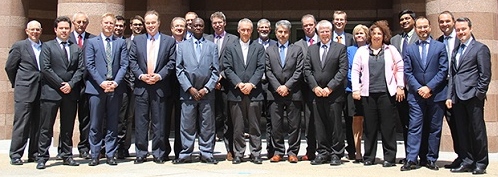
In 2015, based on the lessons learned from the en.lighten initiative, UNEP launched the United for Efficiency (U4E) initiative to support countries in their transition to energy efficient appliances and equipment, including room air conditioners, residential refrigerators, electric motors, distribution transformers and information and communication technologies. The UNEP and Global Environment Facility (GEF) initiative is also supported by United Nations Development Programme (UNDP), International Copper Association (ICA), CLASP, Natural Resources Defence Council (NRDC), Southern African Power Pool, South Africa’s national utility Eskom, as well as leading manufacturers of appliances and equipment such as ABB, Arçelik, Bosch-Siemens Appliances Group, Electrolux, and MABE.
In the lead up to COP21, in Paris on 30 November to 11 December 2015, the initiative will publish country assessments showing the benefits (financial, energy and greenhouse gas) of a transition to energy efficient appliances and equipment. In the coming months, U4E will also convene expert taskforces to develop best practice policy recommendations for each of the products. The taskforces will be compiled from experts from governments, financial institutions, manufactures, and environmental organisations.
U4E stands ready to support countries in their market transformation through the U4E country partnership. Partner countries will receive technical support from the U4E global Centre of Excellence and its private sector partners, allowing them to develop their markets for high efficiency appliances and equipment. Eleven countries have already joined the partnership, from Latin America, Africa, the Middle East and the Pacific. The Southern African Power Pool has also joined, representing utilities from twelve countries.
For further information on the initiative, contact Gustau Mañez Gomis, UNEP Division of Technology, Industry and Economics at or on +33 1 44 37 19 97.
Contribution of Efficient Lighting to Sustainable Consumption and Production Recognised at the SWITCH-Asia Regional Networking Conference
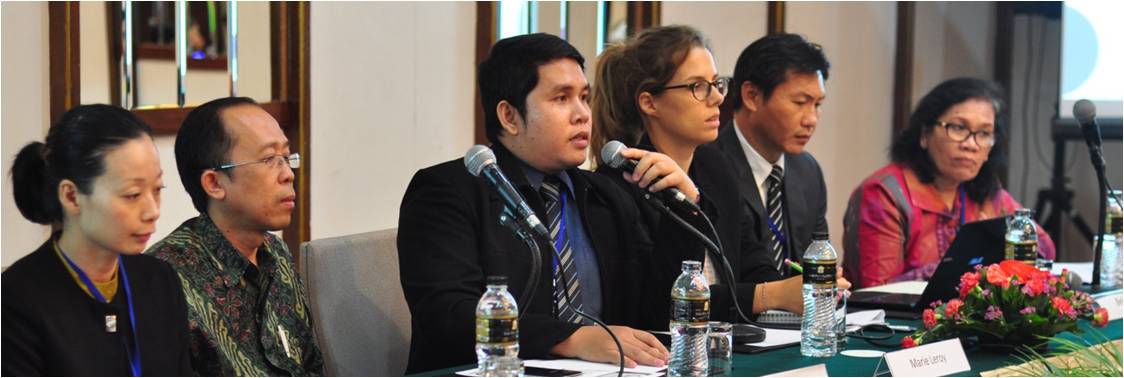
Image courtesy of SWITCH-Asia Network Facility
A regional conference on Advancing Energy Efficiency in Asia Through SCP and Green Finance was organized by the SWITCH-Asia Network Facility in Jakarta on 7-8 July 2015, in cooperation with UNEP, the ASEAN Center for Energy, Indonesia’s Ministry of Energy and Mineral Resources and Yayasan Mitra Hijau. The objective of this conference was to foster knowledge and experience sharing on energy efficiency in the framework of sustainable consumption and production (SCP) programmes in Asia. The meeting brought together over 80 participants from 10 countries across Asia.
The UNEP-GEF en.lighten initiative, represented by Ms. Marie Leroy, facilitated a session on policy and finance mechanisms for energy efficient appliances and equipment. The UNEP-GEF en.lighten initiative’s new guidance note on Developing Minimum Energy Performance Standards for Lighting Products was launched at this occasion. The main recommendations from this session include: the need to regulate energy efficiency at all levels (municipal, national and regional); and the importance of monitoring, reporting and verification systems, with associated enforcement and penalty mechanisms, to ensure effectiveness of policy measures. The session also discussed the potential for regional cooperation on energy efficiency, with the example of the ASEAN regional Standards Harmonization Initiative for Energy Efficiency (SHINE) for air conditioners, which, with the support of UNEP and ASEAN Center for Energy, is soon to be expanded to cover lighting products. Ms. Leroy also facilitated a panel discussion on technology innovation for energy efficiency, bringing together government and private sector representatives.
SWITCH-Asia is a programme funded by the European Commission aimed at promoting economic prosperity and helping reduce poverty in Asia by encouraging a sustainable growth with low environmental impact from industries and consumers, in line with international environmental agreements and processes. Since 2010, SWITCH-Asia has implemented 86 grant projects in 16 Asian countries as well as a number of national and regional policy support components.
The next SWITCH-Asia network event is scheduled for 4-6 November 2015 in India. For more information on the SWITCH-Asia programme, projects and events, please click here.
Implementation and Financing Solutions for Energy Efficient Street Lighting
There has been a clear need for energy efficient technologies that could be applicable in the municipal street lighting sector. A World Bank manual, India: Energy-Efficient Street Lighting—Implementation and Financing Solutions, published in June 2015, provides guidance to support the preparation and implementation of street lighting projects in India, using performance contracting and other public private partnership-based delivery approaches.
The manual draws upon global best practices, including those that have been tried and proposed within India and South Asia; and draws from their failures and successes to document the major lessons learned. It should be useful to help readers in assessing options and developing practical solutions for scaling up the implementation of large street lighting programs in cities and municipalities.
The contents of this manual are designed to act as a practical resource to support industry players, such as equipment suppliers and energy service providers, and government authorities to implement energy efficiency projects in urban street lighting. Although it has been designed according to the requirements and constraints specific to India, many of its recommendations may be applicable across urban local bodies and municipalities in other countries.
To download a copy of the manual, click here.
Informational and Technical Webinars
The UNEP-GEF en.lighten initiative is hosting webinars on monitoring, verification and enforcement topics. To date, ten webinars have been held:
- Lighting Product Benchmarking as an Energy Baseline for Change;
- Developing a Legislative Framework to Support Successful Monitoring, Verification and Enforcement Activities for Energy Efficient Lighting;
- Testing Lamp Efficacy, Lumen Maintenance, Rated Life and Uncertainties;
- Lighting Product Registration Systems: Design and Operation;
- Evaluation Indicators for Energy Efficient Lighting MVE Policy;
- Lamp Product Performance Tests and Interpretation of Results;
- Communication of Lighting Product Performance Standards and Labelling Programmes to Supply Chain Providers;
- CIE Test Method Standard for LED Lamps.
- Best Practices for Enforcing Efficient Lighting Regulations
- Market Baselines and Surveillance for Efficient Lighting Products
The next webinar, How to Create and Operate a Lighting Product Registry, is scheduled for Thursday, 20 August 2015.
To download the presentations and audio recordings from the first ten webinars, click here.
Dates for Your Diary
UNEP-GEF en.lighten initiative lites.asia webinar
How to Create and Operate a Lighting Product Registry
20 August 2015 at 07:00 UTC, 09:00 CEST, 14:00 ICT (TBC)
Next lites.asia meeting and launch of ASEAN SHINE-en.lighten project
October 2015 (TBC) – Bangkok, Thailand
IEC TC 34 Working Group Meetings
October 2015 – Denver, United States of America
4-6 November 2015 – New Delhi, India
